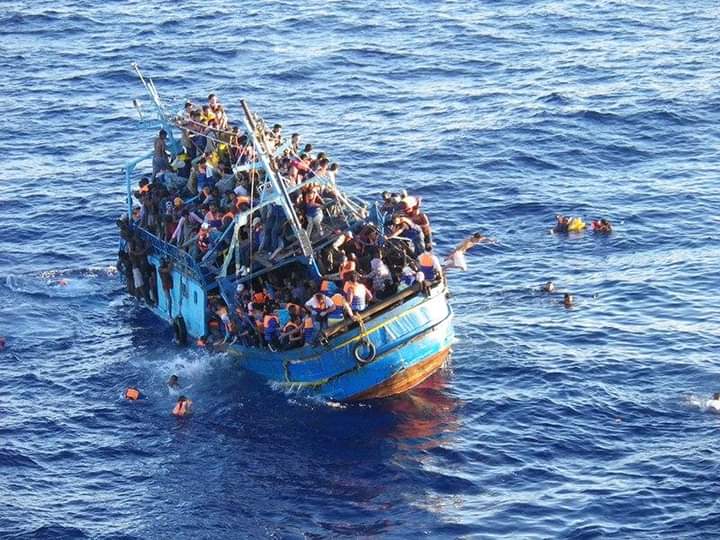
by Alagi Yorro Jallow.
Part I
MAMUDU: Decades pass, yet nothing changes. The Atlantic Cemetery continues to consume the youth and human resources of the African continent, particularly the small nation of Gambia, which is rich in natural and human resources but has been failed by its leaders due to administrative shortsightedness and poor governance. May those who have perished in the oceans find peace in Alijannah Firdausi. However, we, the living, must do more than rest or compose obituaries and eulogies, or offer prayers for the departed souls while our homes are in turmoil. While some youths are restrained from leaving, others are beckoned to return: What then, is the essence of contemporary mobility? The devastating loss of young lives during dangerous sea crossings is a deeply distressing issue that calls for compassion and decisive action from African leaders. These youths often undertake these perilous trips in hopes of finding better
opportunities, propelled by economic difficulties, political unrest, and a lack of future prospects in their homelands. It is imperative for African leaders to tackle the fundamental causes of migration by enhancing economic conditions, generating employment opportunities, and promoting political stability. Cultivating an environment where the youth can prosper and envision a future within their own nations can greatly diminish the necessity for such hazardous expeditions.
Additionally, it is important for leaders to collaborate with international bodies and neighboring states to create secure and lawful migration routes, while also offering aid and protection to those in need.
In the Gambia, the issue of irregular emigration has been a persistent topic for over two decades. Media coverage of this social phenomenon has become an epiphenomenon due to the frequent and trivialized reports of victims in the Mediterranean, Atlantic, and Sahara Desert, which appears to be ineffective or even counterproductive. The more the discourse on irregular emigration and its human and social toll is amplified, the more the youth seem to embark on these journeys. It appears that no measure or individual can halt their departure. This raises the question of whether the discourses—political, religious, scientific, and popular—aimed at deterring or enlightening these emigrants truly grasp the complexity of contemporary international migration, including the economic, social, and crucially, the psychological profiles of these individuals.
Analyzing migration solely through an economic lens often results in a social impasse or an intellectual illusion. Instead of concentrating on the obvious causes or stark consequences of irregular migration from Sub-Saharan Africa, especially from Gambia, to Western countries and the Near and Middle East, it is more pertinent to examine the power structures that construct the identity of migrants (Le Bras, 2012), while also stigmatizing and criminalizing migration. The labels “migrants,” “refugees,” and “asylum seekers” are less indicative of uniform social entities and more reflective of governance strategies and classifications primarily established by Western nations to manage these populations.
The “liberal paradox,” as unveiled by Hollifield in 1992, captures the inherent contradictions in Western migration policies. It highlights the clash between the liberal ideals of openness and free movement and the political desire of states to control immigration and safeguard sovereignty. Specifically, the paradox lies in the necessity for liberal democracies to promote the free flow of capital, goods, and ideas to foster economic growth, while simultaneously fearing the risks associated with the free movement of people. This paradox, which pertains to the management of modern mobility, echoes a fundamental contradiction in liberalism, where the system readily “puts in cages” (Mbembe, 2020) certain groups perceived as intrusive or threatening.
In the dynamic of othering within stereotypical categories, the “paradigm of immobility” (Gemenne, 2020) emerges. This paradigm portrays migration as an anomaly or a cyclical issue that should be contained. To make this disturbing notion widely accepted and heard, migration detractors often utilize “ideological discourses centered on three main elements: the threshold of tolerance, the migration crisis, and the great replacement” (Bouamama, 2021). These elements, which accompany the disparagement of migration and migrants, conjure in the public mind the image of an excess of invaders threatening the serenity of a peaceful host population. Consequently, this narrative is so pervasive that governments and influential figures in the migrants’ origin countries accept it unquestioningly. They even blame migrants, overlooking the fact that “the mobility afforded to capital is denied to the wretched of the earth, who must navigate dangerous sea and land routes to cross borders they did not establish, and who are considered unwelcome in countries that may have contributed to the destruction of their homelands” (Estes, 2023).
Nick Estes’ critique of those opposing irregular migrants reveals that while these opponents are not without fault, the issue of migration is far more intricate than it appears. It is not merely a consequence of non-traditional practices that benefit the West and harm developing nations, but also part of a strategic and exploitative dynamic that turns the migrant into a “geopolitical tool” and a “development agent” subject to manipulation. There is a deliberate effort to portray migrants as outsiders, undesirables whose movements and acceptance need to be managed. In contrast, host nations gain considerably from these migrants who bolster a substantial portion of their economies. Yet, it is important to note that the business sector does indeed desire immigrant labor in the West, but only under conditions that render it frightened, subjugated, and exposed (McNally, 2006). Once acclimatized, this immigrant labor force can significantly aid the economic progress of their new countries.
So, as long as the authorities of the countries of departure of irregular migrants have not understood the issues and subtleties associated with the governance and instrumentalization of international migration, it would be difficult to understand this phenomenon. This is why it is important to address it strategically and courageously with all the stakeholders involved: host countries, the International Organization for Migration (IOM), humanitarian organizations, researchers, specialists, etc. This is all the more so given that considering the enthusiasm that accompanies the promotion of tourism (and tourists) and the concomitant stigmatization of migration (and migrants), it is easy to understand the issue of “mobility justice” (Sheller, 2018).
This concept allows reflection on the ways power and inequality shape governance and control over movement, influencing patterns of unequal mobility and immobility among people, resources, and information (Sheller, 2018). Sheller illustrates this by linking the unregulated exploitation of natural resources in the Global South to climate change, armed conflict, and the forced migration of vulnerable populations to the Global North. Thus, everything is interconnected. Consequently, it would be inconsistent and inappropriate to focus solely on the responsibility of irregular migrants, often depicted as “suicidal,” “impatient,” “thoughtless,” or “adventurous.” Such a caricatured view of irregular migrants oversimplifies the issue by overlooking their agency. Until recently, these individuals were depicted as passive and inactive.
Another dimension rarely mentioned in irregular migration, which has become a hydra, concerns the financial dimension associated with the so-called securing of borders. From smugglers to high-tech industries, to community security organizations such as the European Border and Coast Guard Agency (Frontex), irregular migration mobilizes so much capital that Rodier (2012) calls anti-immigration measures a “xenophobia business.”
Walia (2023) notes that the fervor for security has transformed borders into dystopian testing grounds, leading to the emergence of a $500 billion border security industry (Dunbar-Ortiz, 2006). This industry is developing a “virtual wall” through the deployment of invasive electronic surveillance, automated decision-making, predictive analytics, facial recognition, and biometric systems. Companies like Amazon, Palantir, Elbit Systems, and European Dynamics are trialing these technologies on migrants and refugees. Given the involvement of multinational corporations in the facade of securing host country borders and the billions of dollars circulating in the battle against irregular migration, there is an urgent need to reconsider migration policies in the context of the new liberal order. This order readily promotes tourism in all its forms, including its most controversial ones, yet it overlooks the abuse and massive loss of life associated with irregular migration.
In reality, the West’s ambiguous and insidious stance on tourism and migration is evident in the terminology used to describe the mishaps associated with these two types of mobility: terms like “clandestine,” “irregular,” and especially “illegal” migration are used to underscore the legal aspects of this supposed offense, punishable by deportation, imprisonment, or even deadly physical harm. In contrast, phrases such as “mass tourism,” “overtourism,” or “sex tourism” are employed, overlooking the legal implications of these tourists’ actions, as well as the environmental (coastal erosion, land speculation) and economic (capital flight, real estate speculation) impacts of tourism, especially on Southern countries. Indeed, the disparity in the scrutiny given to tourism and migration (and consequently, to the tourist and the migrant) is also mirrored in the statistics of these two mobility forms.
For instance, only 3.5% of the global population is affected by migration (IOM, 2023), which translates to 244 million international migrants. Among these, 120 million are moving northward, and 124 million southward (IOM, 2023). Meanwhile, international tourism has surged to one billion participants (UNWTO, 2023). These statistics clearly indicate that the number of migrants is significantly lower than that of tourists.
Furthermore, United Nations data (UN, 2021) reveals that out of the 258 million international migrants recorded globally in 2017, 110 million originated from Asia, 64 million from Europe, 39 million from Latin America and the Caribbean, and just 38 million from Africa. Hence, the presumption that the majority of migrants come from Africa is contradicted by the actual figures.
Confronted with the dynamics of power and the semantic pitfalls that govern international mobility (tourism and migration), political figures, academics, and thought leaders in Southern countries like the Gambia must initially dismantle the deception that has nearly convinced the populace that tourists are beyond criticism and must be accepted unconditionally, while migrants (regardless of the labels applied to them) are viewed as desperate, fleeing their homeland, or subject to relentless scrutiny throughout their journey. Furthermore, these stakeholders should undertake to rigorously evaluate and compare the economic and socio-cultural impacts of Western tourists and sub-Saharan migrants on their host nations. The findings from these comparative analyses will provide a factual and robust foundation for reevaluating contemporary mobility, which is often addressed in an emotional, sensationalist, or populist manner.
Ultimately, instead of reinforcing Euro-centric views on mobility that often induce guilt in migrants, the countries from which migrants originate, whether through regular or irregular channels, should bolster their sovereignty in various domains such as economic, political, touristic, and cultural. They should also protect and develop their natural and mineral resources, and initiate a fair and autonomous discourse with the host countries of these migrants. This approach may start to shift the balance of power. Compassion and active initiatives are vital to avert these tragedies and to pave the way for a future where young Africans can fulfill their aspirations without endangering their lives.
References:
1. Between January and December 2023, a total of 4,372 migrants vanished while attempting to traverse the Mediterranean, the Atlantic, and the Sahara Desert. These disappearances are predominantly attributed to presumed drowning, dehydration, or hypothermia. Often, the nationalities of individuals who die or disappear remain unidentified, although they are primarily from sub-Saharan Africa. (IOM, 2023)
2. Governmentality, a term introduced by Michel Foucault, denotes the specific rationality associated with the governance of populations. At the European level, this form of governmentality strengthens international cooperation among various bureaucracies (such as Frontex), focusing less on territorial control and more on the management of populations, particularly migrants.
3. Dr. David Brian (2022). “What is contemporary mobility a synonym for?” A dialogue between an immigrant and a tourist in Paris, published by l’Harmattan.
4. In psychology, agency refers to the self-perception of being an active participant in the world, capable of effecting change, rather than merely experiencing events.

